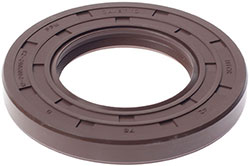
An oil seal is a device designed to seal the joints of rotating parts of a car. Despite the seeming simplicity and extensive experience of use in cars, the design and selection of this part is quite an important and difficult task.
Misconception 1: To select an oil seal, it is enough to know its dimensions
Size is an important, but far from the only parameter. With the same size, oil seals can radically differ in their properties and scope. For the correct choice, you need to know the temperature regime in which the oil seal will work, the direction of rotation of the shaft of the installation, whether design features such as double-breasted are required.
Conclusion: for the correct selection of the oil seal, you need to know all its parameters, and what requirements are set by the car manufacturer.
Misconception 2. The oil seals are all the same and the differences in price stem from the greed of the manufacturer
In fact, oil seals can be made of different materials or by different methods.
Materials used for the production of oil seals:
● ACM (acrylate rubber) - application temperature -30 ° C ... + 150 ° C. The cheapest material, very often used for the manufacture of hub oil seals.
● NBR (oil-and-gasoline-resistant rubber) - application temperature -40 ° C ... + 120 ° C. It is characterized by high resistance to all types of fuel and lubricants.
● FKM (fluororubber, fluoroplastic) - application temperature -20 ° C ... + 180 ° C. The most common material for the production of camshaft oil seals, crankshafts, etc. It has a high resistance to a variety of acids, as well as to solutions, oils, fuels and solvents.
● FKM+ (branded fluororubbers with special additives) - application temperature -50 ° C ... + 220 ° C. Patented materials produced by a number of large chemical holdings (Kalrez and Viton (manufactured by DuPont), Hifluor (manufactured by Parker), as well as materials Dai-El and Aflas). They differ from conventional fluoroplastic by an extended temperature range and increased resistance to acids and fuels and lubricants.
It is also important to note that during operation, the oil seal does not touch the surface of the shaft, the seal occurs due to the creation of a vacuum in the area of rotation of the shaft using special notches. Their direction must be taken into account when selecting, otherwise the notches will not suck oil into the body, but on the contrary - push it out of there.
There are three types of notches:
● Right rotation
● Left rotation
● Reversible
In addition to the material, the oil seals also differ in production technology. Today, two methods of production are used: making with a matrix, cutting from blanks with a cutter. In the first case, deviations in the dimensions and parameters of the oil seal are not allowed at the technological level. In the second, with a large volume of production, deviations from tolerances are possible, as a result of which the oil seal already has dimensions different from the specified ones. Such an oil seal may not provide a reliable seal and will either start to leak from the very beginning, or quickly fail due to friction on the shaft, simultaneously damaging the surface of the shaft itself.
Holding a new oil seal in your hands, try to bend its working edge: in a new oil seal, it should be elastic, even and sharp. The sharper it is, the better and longer the new oil seal will work.
Below is a brief comparison table of oil seals, depending on the type of materials and production method:
| Cheap NBR | High-quality NBR | Cheap FKM | Quality FKM | FKM+ | |
|---|---|---|---|---|---|
| Overall Quality | Poor quality of workmanship and/or material used | High quality of workmanship and material used | Poor quality of workmanship and/or material used | High quality of workmanship and material used | High quality of workmanship and material used |
| Edge processing | The edges are not machined | The edges are machined | The edges are not machined | The edges are machined | The edges are processed (including with a laser) |
| Boarding: | Most are single-breasted | Double-breasted, if necessary structurally | Most are single-breasted | Double-breasted, if necessary structurally | Double-breasted, if necessary structurally |
| Jag | No | There is, if necessary constructively | It may not be | There is, if necessary constructively | There is, if necessary constructively |
| Production engineering | Cutting with a cutter | Matrix production | Matrix production | Matrix production | Matrix production |
| Material of manufacture | Oil-resistant rubber | Oil-resistant rubber with specialized additives | Cheap PTFE without specialized additives | High-quality PTFE | High-quality PTFE with specialized additives (e.g. Viton) |
| Certification | Some products may not be certified | Products are certified | Some products may not be certified | Products are certified | The entire nomenclature is certified according to TR CU |
| Temperature Range | -40°C ... +120°C (actual may be lower) | -40°C ... +120°C | -20°C ... +180°C (actual may be lower) | -20°C ... +180°C | -50°C ... +220°C |
Post time: Jul-13-2023
